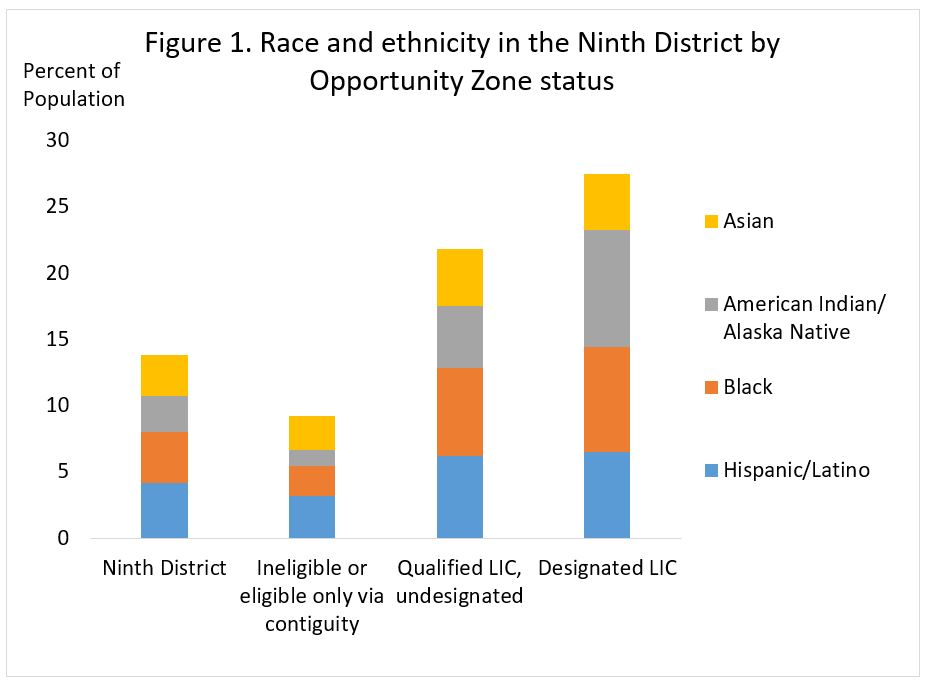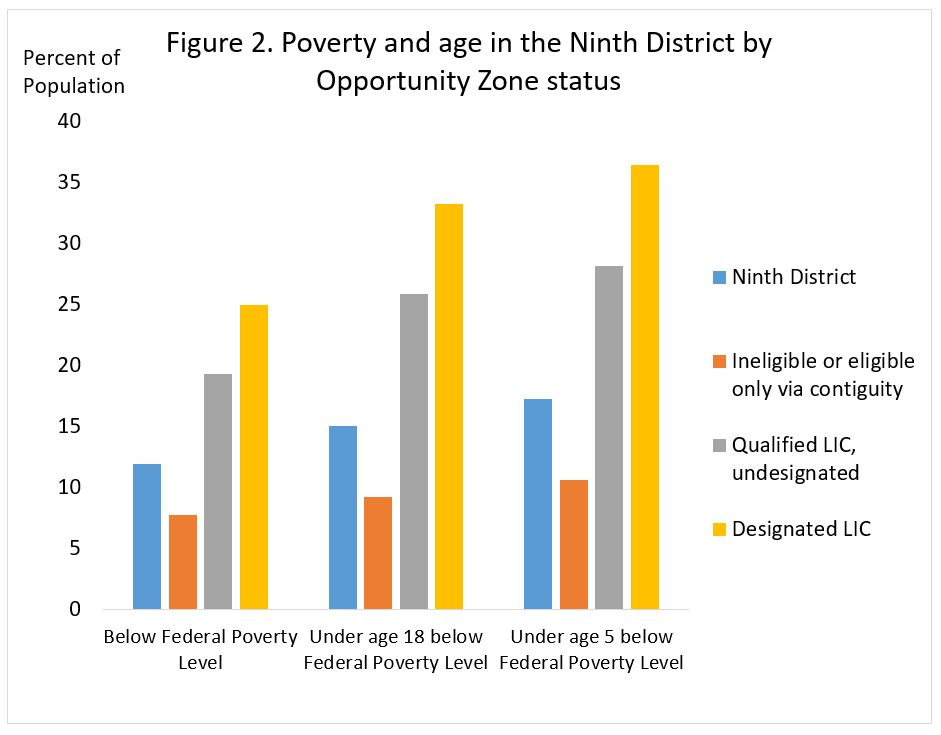This post is one in a series about the federal government’s new Opportunity Zones program, which provides tax benefits to investors who invest and hold capital gains in eligible assets in select low-income census tracts. For details on how Opportunity Zones work, see our previous CD360 Notebook posts that provide an overview and questions about the program.
The new Opportunity Zone program may have a disproportionately large impact on communities of color and Native Americans in the Ninth Federal Reserve District. Opportunity Zone tracts, which were selected by the region’s governors, stand out demographically and economically from Ninth District tracts that were ineligible, and from those that were eligible for Opportunity Zone status but were not selected.
Ninth District tracts and facts
The Ninth District contains 2,379 census tracts. These tracts can be broken down in three ways concerning Opportunity Zones:
- Eligible based on tract income levels. These 843 tracts were eligible for Opportunity Zone status because family incomes within the tract were below a federally determined level. In Opportunity Zone jargon, they represent low-income communities (LICs).
- Eligible based on proximity to LICs. These 482 tracts were eligible if they were contiguous with an LIC that was designated as an Opportunity Zone.
- Ineligible. The remaining 1,054 tracts were not eligible for an Opportunity Zone designation.
The maximum number of tracts governors could propose to be designated as Opportunity Zones was determined by the number of LICs within their respective states. They could select a number of tracts equal to 25 percent of that number. Up to five percent of selected tracts could be eligible based on contiguity. The U.S. Department of the Treasury was responsible for making the final Opportunity Zone designation.
The Ninth District contains only relatively small areas of Wisconsin and Michigan, whose governors selected a slightly higher proportion of tracts that lie within the Ninth District relative to the tracts in the rest of their respective states. The total of 240 designated Opportunity Zones means that the ratio of Opportunity Zones to LICs is actually 28 percent within the Ninth District; 236 of the total were LICs and four (2 percent) were LIC-contiguous.
Racial and ethnic demographics in Opportunity Zones
The Ninth District has about 7.7 million residents who are white and non-Hispanic; about 8 percent of them live in an Opportunity Zone. By contrast, 1.5 million Ninth District residents are non-white and non-Hispanic; 19 percent of them live in an Opportunity Zone. Put another way, people who do not identify as solely white make up 16 percent of the Ninth District, but 30 percent of the population in Opportunity Zones (see Figure 1 for a breakdown of the largest racial and ethnic groups).

View full size Source: 2012-2016 ACS 5-year estimates
Native Americans are particularly overrepresented in Opportunity Zones. Roughly a third of the Ninth District’s Native Americans live in the Opportunity Zones, where they make up 9 percent of the population compared to 2 percent in the rest of the Ninth District.
Income levels in Opportunity Zones
Opportunity Zones are, by definition, lower-income than the rest of the Ninth District. To be eligible as an LIC, a tract could either have a poverty rate that exceeds 20 percent, based on the federal poverty level of about $25,000 for a family of four, or a median family income that is below 80 percent of a metro or statewide median income. Of the 240 Opportunity Zones, 145 qualified based on their poverty status. The governors’ selections also highlighted the disproportionate number of young children who live in families that get by on less-than-poverty-level incomes.
In tracts that were ineligible for Opportunity Zone status based on tract income levels, 7 percent of the residents live below the federal poverty level. By comparison, 25 percent of residents of Opportunity Zones live below the federal poverty line. The poverty level in designated Opportunity Zone tracts was also higher than in undesignated LIC tracts, where 19 percent of residents live below the poverty line.
The differences are starker among the young. Among children under the age of 18 living in tracts ineligible for Opportunity Zone status, 9 percent live in poverty. In contrast, among children in designated Opportunity Zone tracts, 33 percent live below the poverty line, including 36 percent of all children under the age of 5 (see Figure 2).

View full size Source: 2012-2016 ACS 5-year estimates
Additional resources
Enterprise Community Partners and the Economic Innovation Group, two groups involved in advocacy work about the Opportunity Zones, have both created maps that display demographic and economic data on Opportunity Zones around the country.





